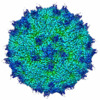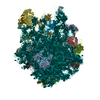[English] 日本語
 Yorodumi
Yorodumi- EMDB-6433: VHH complexes with poliovirus: cryo-electron microscopy studies a... -
+ Open data
Open data
- Basic information
Basic information
| Entry | Database: EMDB / ID: EMD-6433 | |||||||||
|---|---|---|---|---|---|---|---|---|---|---|
| Title | VHH complexes with poliovirus: cryo-electron microscopy studies at near-atomic resolution | |||||||||
 Map data Map data | Reconstruction of VHH-poliovirus complex (PVSS8A-Mahoney Type 1 complex) | |||||||||
 Sample Sample |
| |||||||||
 Keywords Keywords | poliovirus / nanobodies / VHH / neutralizing antibodies | |||||||||
| Function / homology |  Function and homology information Function and homology informationsymbiont-mediated suppression of host translation initiation / symbiont-mediated suppression of host cytoplasmic pattern recognition receptor signaling pathway via inhibition of RIG-I activity / symbiont-mediated suppression of host cytoplasmic pattern recognition receptor signaling pathway via inhibition of MDA-5 activity / symbiont-mediated suppression of host cytoplasmic pattern recognition receptor signaling pathway via inhibition of MAVS activity / picornain 2A / symbiont-mediated suppression of host mRNA export from nucleus / symbiont genome entry into host cell via pore formation in plasma membrane / picornain 3C / T=pseudo3 icosahedral viral capsid / ribonucleoside triphosphate phosphatase activity ...symbiont-mediated suppression of host translation initiation / symbiont-mediated suppression of host cytoplasmic pattern recognition receptor signaling pathway via inhibition of RIG-I activity / symbiont-mediated suppression of host cytoplasmic pattern recognition receptor signaling pathway via inhibition of MDA-5 activity / symbiont-mediated suppression of host cytoplasmic pattern recognition receptor signaling pathway via inhibition of MAVS activity / picornain 2A / symbiont-mediated suppression of host mRNA export from nucleus / symbiont genome entry into host cell via pore formation in plasma membrane / picornain 3C / T=pseudo3 icosahedral viral capsid / ribonucleoside triphosphate phosphatase activity / host cell cytoplasmic vesicle membrane / nucleoside-triphosphate phosphatase / channel activity / monoatomic ion transmembrane transport / RNA helicase activity / endocytosis involved in viral entry into host cell / symbiont-mediated activation of host autophagy / RNA-directed RNA polymerase / cysteine-type endopeptidase activity / viral RNA genome replication / RNA-directed RNA polymerase activity / DNA-templated transcription / virion attachment to host cell / host cell nucleus / structural molecule activity / proteolysis / RNA binding / zinc ion binding / ATP binding / membrane Similarity search - Function | |||||||||
| Biological species |   Human poliovirus 1 Human poliovirus 1 | |||||||||
| Method | single particle reconstruction / cryo EM / Resolution: 4.2 Å | |||||||||
 Authors Authors | Strauss M / Schotte L / Thys B / Filman DJ / Hogle JM | |||||||||
 Citation Citation |  Journal: J Virol / Year: 2016 Journal: J Virol / Year: 2016Title: Five of Five VHHs Neutralizing Poliovirus Bind the Receptor-Binding Site. Authors: Mike Strauss / Lise Schotte / Bert Thys / David J Filman / James M Hogle /   Abstract: Nanobodies, or VHHs, that recognize poliovirus type 1 have previously been selected and characterized as candidates for antiviral agents or reagents for standardization of vaccine quality control. In ...Nanobodies, or VHHs, that recognize poliovirus type 1 have previously been selected and characterized as candidates for antiviral agents or reagents for standardization of vaccine quality control. In this study, we present high-resolution cryo-electron microscopy reconstructions of poliovirus with five neutralizing VHHs. All VHHs bind the capsid in the canyon at sites that extensively overlap the poliovirus receptor-binding site. In contrast, the interaction involves a unique (and surprisingly extensive) surface for each of the five VHHs. Five regions of the capsid were found to participate in binding with all five VHHs. Four of these five regions are known to alter during the expansion of the capsid associated with viral entry. Interestingly, binding of one of the VHHs, PVSS21E, resulted in significant changes of the capsid structure and thus seems to trap the virus in an early stage of expansion. IMPORTANCE: We describe the cryo-electron microscopy structures of complexes of five neutralizing VHHs with the Mahoney strain of type 1 poliovirus at resolutions ranging from 3.8 to 6.3Å. All five ...IMPORTANCE: We describe the cryo-electron microscopy structures of complexes of five neutralizing VHHs with the Mahoney strain of type 1 poliovirus at resolutions ranging from 3.8 to 6.3Å. All five VHHs bind deep in the virus canyon at similar sites that overlap extensively with the binding site for the receptor (CD155). The binding surfaces on the VHHs are surprisingly extensive, but despite the use of similar binding surfaces on the virus, the binding surface on the VHHs is unique for each VHH. In four of the five complexes, the virus remains essentially unchanged, but for the fifth there are significant changes reminiscent of but smaller in magnitude than the changes associated with cell entry, suggesting that this VHH traps the virus in a previously undescribed early intermediate state. The neutralizing mechanisms of the VHHs and their potential use as quality control agents for the end game of poliovirus eradication are discussed. | |||||||||
| History |
|
- Structure visualization
Structure visualization
| Movie |
 Movie viewer Movie viewer |
|---|---|
| Structure viewer | EM map:  SurfView SurfView Molmil Molmil Jmol/JSmol Jmol/JSmol |
| Supplemental images |
- Downloads & links
Downloads & links
-EMDB archive
| Map data |  emd_6433.map.gz emd_6433.map.gz | 427.7 MB |  EMDB map data format EMDB map data format | |
|---|---|---|---|---|
| Header (meta data) |  emd-6433-v30.xml emd-6433-v30.xml emd-6433.xml emd-6433.xml | 13.1 KB 13.1 KB | Display Display |  EMDB header EMDB header |
| Images |  400_6433.gif 400_6433.gif 80_6433.gif 80_6433.gif | 120.5 KB 6.3 KB | ||
| Archive directory |  http://ftp.pdbj.org/pub/emdb/structures/EMD-6433 http://ftp.pdbj.org/pub/emdb/structures/EMD-6433 ftp://ftp.pdbj.org/pub/emdb/structures/EMD-6433 ftp://ftp.pdbj.org/pub/emdb/structures/EMD-6433 | HTTPS FTP |
-Related structure data
| Related structure data |  3jbeMC  6434C  6435C  3jbcC  3jbdC  3jbfC  3jbgC M: atomic model generated by this map C: citing same article ( |
|---|---|
| Similar structure data |
- Links
Links
| EMDB pages |  EMDB (EBI/PDBe) / EMDB (EBI/PDBe) /  EMDataResource EMDataResource |
|---|---|
| Related items in Molecule of the Month |
- Map
Map
| File |  Download / File: emd_6433.map.gz / Format: CCP4 / Size: 500 MB / Type: IMAGE STORED AS FLOATING POINT NUMBER (4 BYTES) Download / File: emd_6433.map.gz / Format: CCP4 / Size: 500 MB / Type: IMAGE STORED AS FLOATING POINT NUMBER (4 BYTES) | ||||||||||||||||||||||||||||||||||||||||||||||||||||||||||||||||||||
|---|---|---|---|---|---|---|---|---|---|---|---|---|---|---|---|---|---|---|---|---|---|---|---|---|---|---|---|---|---|---|---|---|---|---|---|---|---|---|---|---|---|---|---|---|---|---|---|---|---|---|---|---|---|---|---|---|---|---|---|---|---|---|---|---|---|---|---|---|---|
| Annotation | Reconstruction of VHH-poliovirus complex (PVSS8A-Mahoney Type 1 complex) | ||||||||||||||||||||||||||||||||||||||||||||||||||||||||||||||||||||
| Projections & slices | Image control
Images are generated by Spider. | ||||||||||||||||||||||||||||||||||||||||||||||||||||||||||||||||||||
| Voxel size | X=Y=Z: 0.986 Å | ||||||||||||||||||||||||||||||||||||||||||||||||||||||||||||||||||||
| Density |
| ||||||||||||||||||||||||||||||||||||||||||||||||||||||||||||||||||||
| Symmetry | Space group: 1 | ||||||||||||||||||||||||||||||||||||||||||||||||||||||||||||||||||||
| Details | EMDB XML:
CCP4 map header:
| ||||||||||||||||||||||||||||||||||||||||||||||||||||||||||||||||||||
-Supplemental data
- Sample components
Sample components
-Entire : Nanobody PVSS8A in complex with poliovirus P1/Mahoney
| Entire | Name: Nanobody PVSS8A in complex with poliovirus P1/Mahoney |
|---|---|
| Components |
|
-Supramolecule #1000: Nanobody PVSS8A in complex with poliovirus P1/Mahoney
| Supramolecule | Name: Nanobody PVSS8A in complex with poliovirus P1/Mahoney / type: sample / ID: 1000 / Details: 1 Oligomeric state: 60 nanobody VHH monomers bind to each poliovirion Number unique components: 2 |
|---|---|
| Molecular weight | Experimental: 9.0 MDa / Theoretical: 9.0 MDa / Method: 1 |
-Supramolecule #1: Human poliovirus 1
| Supramolecule | Name: Human poliovirus 1 / type: virus / ID: 1 / Name.synonym: poliovirus Details: The viral capsid is decorated with 60 copies of a single-domain antibody (PVSS8A). NCBI-ID: 12080 / Sci species name: Human poliovirus 1 / Database: NCBI / Virus type: VIRION / Virus isolate: SEROTYPE / Virus enveloped: No / Virus empty: No / Syn species name: poliovirus / Sci species serotype: 1 |
|---|---|
| Host (natural) | Organism:  Homo sapiens (human) / synonym: VERTEBRATES Homo sapiens (human) / synonym: VERTEBRATES |
| Molecular weight | Experimental: 7 MDa / Theoretical: 7 MDa |
| Virus shell | Shell ID: 1 / Diameter: 350 Å / T number (triangulation number): 3 |
-Macromolecule #1: PVSS8A
| Macromolecule | Name: PVSS8A / type: protein_or_peptide / ID: 1 / Name.synonym: nanobody, VHH Details: 60 copies of this single-domain antibody are attached to the viral capsid. Number of copies: 60 / Oligomeric state: monomer / Recombinant expression: Yes |
|---|---|
| Source (natural) | Organism:  |
| Molecular weight | Experimental: 15 KDa / Theoretical: 15 KDa |
| Recombinant expression | Organism:  |
-Experimental details
-Structure determination
| Method | cryo EM |
|---|---|
 Processing Processing | single particle reconstruction |
| Aggregation state | particle |
- Sample preparation
Sample preparation
| Concentration | 1 mg/mL |
|---|---|
| Buffer | pH: 7.4 / Details: 145 mM NaCl, 50 mM Na2HPO4.12H2O |
| Grid | Details: C-flat 1.2/1.3 |
| Vitrification | Cryogen name: ETHANE / Chamber temperature: 154 K / Instrument: HOMEMADE PLUNGER / Method: 4 second blot |
- Electron microscopy
Electron microscopy
| Microscope | FEI POLARA 300 |
|---|---|
| Temperature | Min: 80 K / Max: 110 K / Average: 80 K |
| Alignment procedure | Legacy - Electron beam tilt params: 0 |
| Details | Gatan K2 operated in Super-resolution mode |
| Date | Nov 27, 2013 |
| Image recording | Category: CCD / Film or detector model: GATAN K2 (4k x 4k) / Digitization - Sampling interval: 2.5 µm / Number real images: 300 / Average electron dose: 25 e/Å2 / Bits/pixel: 8 |
| Electron beam | Acceleration voltage: 300 kV / Electron source:  FIELD EMISSION GUN FIELD EMISSION GUN |
| Electron optics | Calibrated magnification: 25380.7 / Illumination mode: FLOOD BEAM / Imaging mode: BRIGHT FIELD / Cs: 2.26 mm / Nominal defocus max: -4.0 µm / Nominal defocus min: -1.4 µm / Nominal magnification: 23000 |
| Sample stage | Specimen holder: Polara holder / Specimen holder model: OTHER |
| Experimental equipment |  Model: Tecnai Polara / Image courtesy: FEI Company |
- Image processing
Image processing
| Details | The particles were processed using Frealign. |
|---|---|
| CTF correction | Details: per particle |
| Final reconstruction | Resolution.type: BY AUTHOR / Resolution: 4.2 Å / Resolution method: OTHER / Software - Name: Frealign / Number images used: 16421 |
-Atomic model buiding 1
| Initial model | PDB ID: |
|---|---|
| Software | Name: COOT, SPDBV, REFMAC5 |
| Details | Using stereochemically and icosahedrally restrained maximum likelihood refinement in REFMAC5, a representative subset of the full atomic model with all neighbors present was built and refined to fit the corresponding subset of the experimental map. Portions of the model whose density resembled a structural homolog were identified and restrained to agree with the homolog. Detailed atomic models were constructed in areas of difference wherever the resolution of the map permitted. The Fourier-amplitude-weighted average cosine of the phase discrepancy was tracked. |
| Refinement | Space: RECIPROCAL / Protocol: FLEXIBLE FIT Target criteria: ML agreement with Fourier amplitudes and phases |
| Output model |  PDB-3jbe: |
 Movie
Movie Controller
Controller













 Z (Sec.)
Z (Sec.) Y (Row.)
Y (Row.) X (Col.)
X (Col.)






















